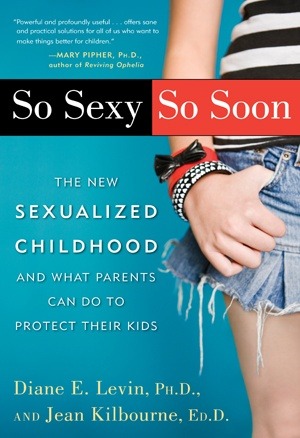Some time ago Jean Kilbourne came to my university to give a lecture on the danger of the media, not only for teenagers, but also for younger kids and parents, too.
It had become clear to me before hearing her lecture that the U.S.’s current society is, to put it blatantly, toxic. With seemingly obvious examples, like rappers spewing lyrics about having sex with women and women dancing seductively with almost no clothes on in the videos that accompany these songs, to more hidden examples, like Disney movies that promote the idea that women are submissive and should exist in their patriarchal world only to wait for and on men, children–both girls and boys–are fed absolutely disgusting ideas that force them into rather rigid gender stereotypes.
But the damage doesn’t stop there. They absorb this information as children, and then become the person your mom warns you about dating: that guy who treats women like crap, or that girl who gives herself away for nothing. And all because they have been raised with these ideas, these ideas that have now become their ‘normal’.
To be honest, if I were the parent of a young child right now, I would be scared for my child. Because no matter how much you protect them, they will still end up going to school, where other (less-protected) children will eventually ruin the protection your child grew up with.
How much will it take and how long will it be until we realize that unless we start talking about how to fix this problem, it will never get fixed, and only keep damaging our most precious asset–our children?
Although this book is already a bit dated–it was only published in 2008, but some of the vocabulary the authors use, such as ‘zine’, and some of the examples they use, such as Britney Spears and the Disney Channel, have since outgrown their popularity–it offers pretty good points and solutions.
One of their most insightful points, although not an original one, is the link between Disney and patriarchy. Anyone who thinks Disney movies such as Snow White, Cinderella, and Sleeping Beauty, encourage anything but passive-minded women who wait to be saved are kidding themselves. Along with this are the media and toys aimed at little boys–Teenage Mutant Ninja Turtles and Power Rangers being among the examples the authors use–which promote nothing but violence. And this is only the beginning of a long list of quite scary examples.
The authors leave us with this thought: that we have to start talking about the damage the media is doing. If we don’t talk about it, it will begin to become our new normal, and we will accept it as such. And that is too big a risk to take.

Hace tiempo vino a mi universidad Jean Kilbourne para dar un discurso sobre el peligro del medio, no solo para los adolescentes sino tampoco para los niños menores y los padres.
Me había hacerse claro para mí antes de su discurso que la sociedad actual de los EEUU es, para decirlo descaradamente, tóxica. Con los ejemplos aparentemente obvios, como los raperos lanzando las letras sobre tener relaciones con las mujeres y las mujeres bailando de manera seductora casi desnudas en los videos que se acompañan a las canciónes, a los ejemplos más escondidos, como las películas de Disney que promueven la idea que las mujeres son sumisas y obedientes y deben existir en su mundo patriarcal solo para esperar por y atender los hombres, los niños–las chicas y los chicos igualmente–están alimentados las ideas absolutamente asquerosas que los obligan a existir en los estereotipos de los géneros muy rígidos.
Pero el daño no para con eso. Adsorben esta información como niños, y luego se hacen la persona que tu madre te adverte sobre salir: ese chico que trata a las mujeres malísimo, o esa chica que se regala para nada. Y todo porque se han criado con estas ideas que se han hecho su ‘normal’.
Para ser honesta, si fuera la madre de un niño jóven ahora mismo, me daría miedo. Porque no importa cuanto puedes protegerles, todavía algún día tiene que irles al instituto, donde otros niños (menos protegidos) eventualmente arruinarán la protección con que tu niño ha criado.
¿Cuanto lo costará y cuanto tiempo lo llevará hasta nos damos cuenta que si no empezamos a hablar sobre como arreglar este problema, nunca lo arreglará y solo quedará en dañar nuestro recurso más precioso–nuestros hijos?
Aunque este libro ya está un poco anticuado–solo estuvo publicado en 2008, pero algún vocabulario que usan las autoras, como ‘zine’, y algunos ejemplos usan, como Britney Spears y el Disney Channel, desde entonces han cansado su popularidad–lo ofrece los puntos y las soluciones buenos.
Uno de sus puntos más profundos, aunque no es original, es el vínculo entre Disney y el patriarcado. Alguien que piensa que las películas de Disney, como Blancanieves, Cenicienta, y Bella Durmiente, estimulan algo salvo las mujeres con las mentes pasivas las quienes esperan para ser salvadas se están bromeando. Junto con eso son el medio y los juguetes para los chicos–Las Tortugas Ninjas y Power Rangers están dos de los ejemplos que usan las autoras–cuales no promueven nada salvo la violencia. Y eso solo es el principio de una lista muy larga de ejemplos bastantes alarmantes.
Las autoras nos salen con este pensamiento: que tenemos qur empezar a hablar sobre el daño que está haciendo el medio. Si no lo hablamos, lo empezará hacerse nuestro nuevo normal, y lo aceptaremos como así. Y eso es un riesgo desmasiado grande.